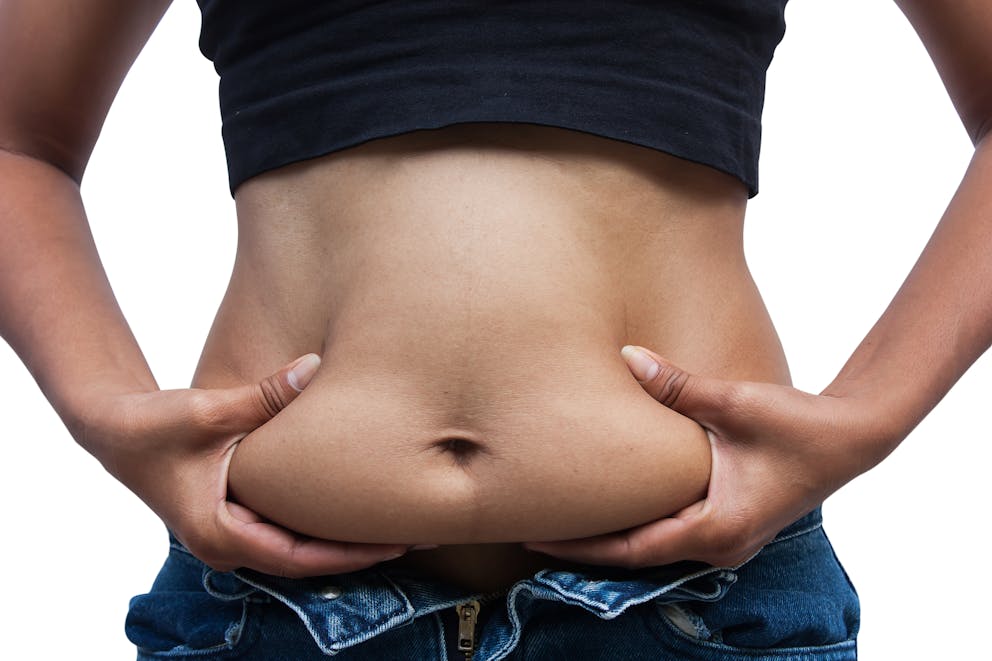How to Flatten a Pooch Belly – Exercise for Lower Stomach Flab
A pooch belly develops due to excess belly fat and weakened muscles in the abdominal wall.
Upright reverse sit-ups strengthen the core muscles in your lower abdomen and tighten your skin simultaneously—a winning combination to flatten a flabby pouch.
Learn how to do upright reverse sit-ups for a flat stomach and discover why a high-fat diet and intermittent fasting are excellent choices to achieve weight loss fast!

What is belly pooch?
Pooch belly is a term used to describe excess fat and loose skin around the belly button and lower abdomen.
Women are more prone to lower abdominal fat and excess skin, which may explain why they’re more likely to opt for surgical options to lose belly fat than men.
However, plastic surgery can have serious side effects and doesn’t address the root cause of excess fat, and a pooch belly can reappear even after a full tummy tuck.
Watch the video below to learn how reserve sit-ups help you achieve a flat stomach.
What causes lower belly pooch?
Loose belly fat is typically caused by weight gain due to a sedentary lifestyle and a diet high in carbs, sugars, and processed foods.
Insulin, a key metabolic hormone, regulates almost all aspects of energy-making processes and fat storage.
Late-night snacking and a high-carb diet can lead to elevated insulin levels, which stimulate excess fat deposition around the liver and organs—the main culprit of a pooch belly.
In some cases, a belly pooch indicates metabolic or hormonal imbalances that can impact your overall health and may increase your risk of heart disease, metabolic syndrome, and insulin resistance.
Hormones play a vital role in shaping your body composition and influence how and where your body stores fat.
Both the liver body type and adrenal body type tend to store fat in the lower abdominal area, explaining why individuals with these hormone body types are more likely to develop a pooch belly.

How to flatten your pooch belly
You can get rid of a pooch belly and flatten your stomach with reverse sit-ups, also known as upright reverse crunch.
Reverse sit-ups burn belly fat, stretch the skin, and strengthen the rectus abdominis, the muscle group commonly known as a six-pack.
“Regularly exercising your core muscles with upright reverse sit-ups targets stubborn pockets of fat around your lower abdomen,” explains Dr. Berg. “And, upright reverse crunches tighten your abdominal skin, which helps counteract flabby skin due to weight loss.”
A study published in Strength and Conditioning found that reverse sit-ups are a highly effective exercise that enhances core stability while reducing the risk of lower back issues.
How to do upright reverse sit-ups
To get into your starting position, stand up with your feet flat on the ground, thighs parallel, neck forward, and knees bent slightly. Place your hands on your lower abs or behind your head to support your neck.
Take a deep inhale and exhale, engage your lower and upper abs, and slowly lean backward until you feel a stretch in your abdominal region.
Hold this position briefly and use your core muscles to pull your upper body back into an upright position.
Repeat for at least 25 repetitions. Take a brief rest and continue doing a second set. As you gain core strength, increase the number of repetitions and sets.
If you experience any discomfort or pain in your hips, neck, or lower back area, consult a healthcare provider or certified personal trainer before trying this exercise.

Why sit-ups are the worst exercise for belly pooch
This might be surprising, but sit-ups are the worst exercise for that lower belly fat pooch.
Traditional sit-ups and crunches only target the upper abdominal muscles, which makes it difficult to reduce belly fat in the lower abdomen.
In addition, sit-ups can place significant compression on your lumbar spine, which may explain why they’re among the most common causes of exercise-related lower back pain.
In contrast, upright reverse crunches strengthen your upper and lower abdominal muscles without excessive compression or flexion on your spine.

More ways to get rid of a lower pooch belly
While regular core stability exercises are crucial to achieving a flat stomach, making beneficial dietary choices is equally vital to getting rid of a belly pooch quickly.
A nutritious low-carb, high-fat diet like Healthy Keto® shifts your body into fat-burning mode and forces your metabolism to utilize fat as a primary fuel source.
Limiting carbs and sugars while obtaining most of your calories from healthy fats helps get rid of love handles and benefits your metabolic health.
If you want to take fat-burning to another level, combine Healthy Keto with intermittent fasting, which is an eating pattern that cycles between fasting and eating windows.
Research published in the Annual Review of Nutrition concludes that caloric restriction during fasting periods forces the liver to utilize stored body fat for energy, which promotes rapid weight loss, especially around the abdominal area.

How long does it take to see results?
How long it takes to get rid of a pooch belly depends on various factors, including age, body weight, and abdominal muscle mass.
While some people may see noticeable improvements within two weeks of regular upright reverse sit-ups, others may need several months to lose stubborn fat.
Because belly fat is typically directly linked to excess weight, following a low-carb ketogenic diet and practicing intermittent fasting is equally important as core stability exercises.

Key takeaways
Upright reverse sit-ups are a highly effective exercise that helps eliminate belly fat, tone your abdominal skin, and flatten your stomach.
Combining daily upright reverse sit-up exercises with Healthy Keto and intermittent fasting is a perfect strategy to burn body fat, improve core stability, and get rid of a pooch belly fast.
FAQ
1. What is a pooch belly?
A pooch belly is characterized by excess fat and loose skin around the lower abdomen, which gives the stomach a rounded and flabby appearance.
2. What causes a pooch belly?
Most cases of pooch belly are caused by weight gain, excess fat deposits around the liver and organs, and weak abdominal muscles. Belly fat can also be linked to hormonal imbalances triggered by chronic stress, poor dietary choices, or nutrient deficiencies.
3. Why do I have lower stomach flab?
A diet high in carbs and sugars, eating too many processed foods, and frequent snacking can cause metabolic imbalances and increase the risk of weight gain and a flabby pouch.
In addition, rapid weight loss, age, and multiple pregnancies can cause a loss of abdominal skin elasticity, significantly contributing to stomach flab.
4. How do I get rid of my belly pooch?
Regularly exercising the lower abdominal core muscles with reverse sit-ups and following a low-carb keto diet helps you lose fat around the middle, which is crucial to eliminating a belly pooch.
5. Are sit-ups good for a pooch belly?
No, sit-ups aren’t effective in flattening a pooch belly. Traditional sit-ups exercise only the upper abdominal muscles, making it challenging to lose lower belly fat.
6. What are upright reverse sit-ups?
Upright reverse sit-ups are a moderately challenging core exercise that targets core strength and tones abdominal skin, which helps flatten a pooch belly quickly.
7. How do upright reverse sit-ups get rid of belly pooch?
Regularly performing upright reverse crunches strengthens your core muscles and tightens your abdominal skin, which makes them a highly effective exercise to burn belly fat and achieve a flat stomach fast.
8. Is keto good for a pooch belly?
Yes, keto is an excellent diet that helps you lose weight and get rid of a pooch belly quickly. Limiting carb intake keeps insulin levels balanced and pushes your metabolism to burn fat instead of sugar as the primary fuel source, which promotes metabolic health and weight loss.
9. Is tummy tuck surgery the best way to get rid of belly pooch?
While tummy tuck surgery can temporarily fix a pooch belly, it doesn’t address the underlying causes, such as a poor diet, chronic stress, or hormonal imbalances. Not only can a pooch belly reappear after plastic surgery, but it’s also associated with side effects, including scarring, blood clots, and the risk of serious infections.
Previous blog
How Do I Figure Out My IF Frequency PatternNext blog
The Worst and Best Carb on Keto
Popular
08/21/2024
55.7K views
02/23/2025
46.8K views
11/18/2024
281K views
03/18/2024
11/21/2022




